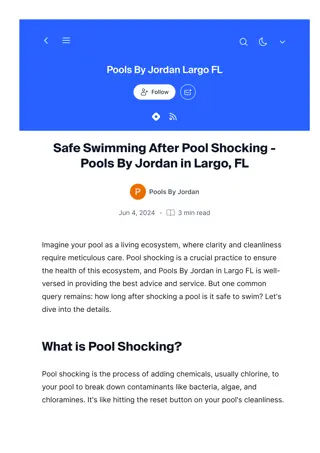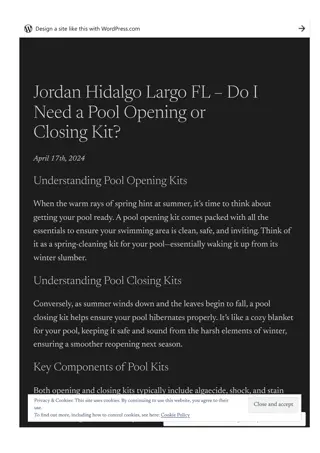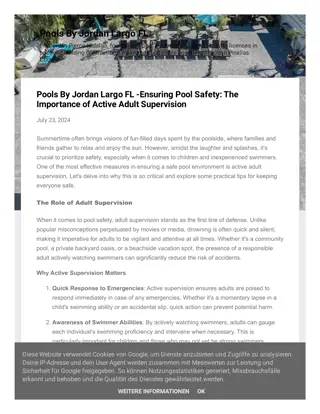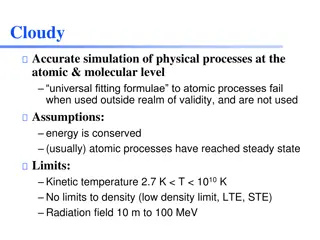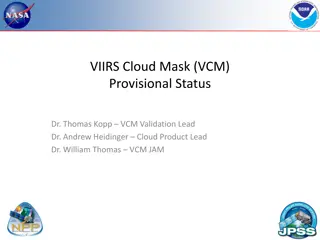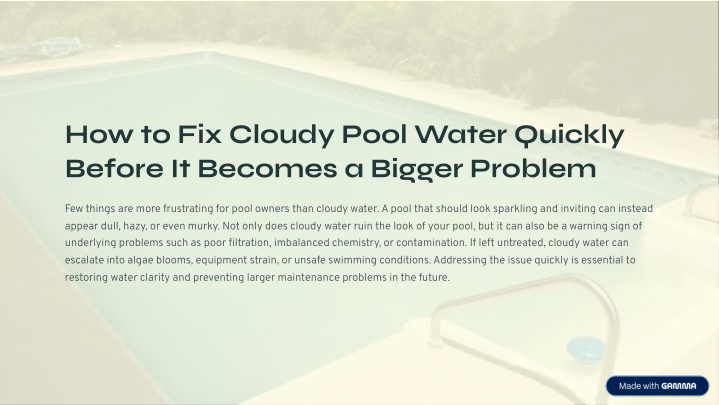
Jordan Hidalgo Largo FL - How to Fix Cloudy Pool Water Quickly Before It Becomes
Cloudy pool water can appear suddenly, but with the right knowledge and swift action, it can also be corrected quickly before turning into a bigger maintenance issue. By balancing chemicals, shocking when necessary, improving filtration, and addressi
Download Presentation

Please find below an Image/Link to download the presentation.
The content on the website is provided AS IS for your information and personal use only. It may not be sold, licensed, or shared on other websites without obtaining consent from the author. If you encounter any issues during the download, it is possible that the publisher has removed the file from their server.
You are allowed to download the files provided on this website for personal or commercial use, subject to the condition that they are used lawfully. All files are the property of their respective owners.
The content on the website is provided AS IS for your information and personal use only. It may not be sold, licensed, or shared on other websites without obtaining consent from the author.
E N D
Presentation Transcript
How to Fix Cloudy Pool Water Quickly Before It Becomes a Bigger Problem Few things are more frustrating for pool owners than cloudy water. A pool that should look sparkling and inviting can instead appear dull, hazy, or even murky. Not only does cloudy water ruin the look of your pool, but it can also be a warning sign of underlying problems such as poor filtration, imbalanced chemistry, or contamination. If left untreated, cloudy water can escalate into algae blooms, equipment strain, or unsafe swimming conditions. Addressing the issue quickly is essential to restoring water clarity and preventing larger maintenance problems in the future.
Understanding the Most Common Causes of Cloudy Pool Water Poor Water Chemistry Inadequate Filtration Environmental Factors Low chlorine levels or imbalanced pH and alkalinity allow bacteria and organic matter to build up, creating haziness. Clogged filters, short pump run times, or weak circulation allow debris and fine particles to remain suspended in the water. Heavy rain, excessive pollen, or nearby construction can introduce extra contaminants that overwhelm the pool's normal systems. Cloudy pool water is often the result of multiple factors working together. By identifying the root cause, you can choose the right corrective action instead of just masking the symptoms.
Testing and Balancing Water Chemistry The fastest and most reliable way to address cloudy water is to start with a full water test. Use a reliable testing kit to measure chlorine, pH, alkalinity, calcium hardness, and stabilizer levels. 1-3 ppm 7.2-7.6 80-120& Chlorine pH Level Alkalinity Ideal range for effective sanitization Balanced range for chlorine efficiency Optimal range for water stability If chlorine is too low, bacteria and organic waste will not be oxidized effectively, resulting in cloudy conditions. Correcting this often requires shocking the pool with a higher dose of chlorine to restore sanitizer levels. Equally important is ensuring that pH is balanced4levels that are too high or too low reduce chlorine efficiency and encourage scale or corrosion, which can further cloud the water. By quickly adjusting chemicals to their recommended ranges, you provide the foundation for clear water to return.
Shocking the Pool With a Chlorine Boost What is Pool Shocking? Best Practices Shocking the pool involves adding a concentrated dose of chlorine, usually in the form of liquid chlorine or granular calcium hypochlorite. This high level of sanitizer works to oxidize organic matter, kill bacteria, and clear contaminants that regular chlorine levels cannot handle. Shock the pool at night when the sun cannot break down chlorine Run the pump continuously to distribute the treatment Wait until chlorine levels return to a safe range before swimming Depending on the severity of the cloudiness, a single shock may restore clarity within 24 hours, but in stubborn cases, multiple treatments may be required. Remember to wait until chlorine levels return to a safe range before allowing swimmers back into the pool.
Improving Filtration and Circulation Even perfectly balanced water chemistry will not solve cloudy water if the filtration system is underperforming. Filters trap dirt, debris, and microscopic particles, but when clogged or neglected, they can no longer do their job effectively. Optimize Water Flow Extend Pump Run Time Position return jets downward and angled to improve circulation by stirring up water in "dead zones" that otherwise allow contaminants to settle. Check Filter Condition Clean or backwash sand and D.E. filters to remove built-up debris, and hose down or replace cartridge filters if needed. Run the pump longer48 to 12 hours a day during problem periods4to ensure continuous circulation, which helps clear suspended particles. Enhancing filtration and circulation gives your sanitizer and chemicals the chance to work evenly throughout the entire pool, addressing cloudy water more effectively.
Using Pool Clarifiers or Flocculants Sometimes cloudy water is caused by particles so fine that even a functioning filter cannot catch them. In these cases, pool clarifiers and flocculants offer a quick fix. Clarifiers Bind tiny particles together into larger clumps that can be captured by the filter. Easy to use and ideal for minor cloudiness. Flocculants Cause fine particles to sink to the bottom of the pool, where they can be vacuumed out manually. Faster but requires more effort. Both methods provide a short-term solution to cloudy water, but they should be combined with proper chemistry and filtration improvements to prevent the issue from returning.
Addressing Environmental Factors Beyond internal chemistry and filtration problems, external factors can cause cloudy water. Rainstorms often introduce phosphates, dirt, and organic debris into the pool, while wind can carry pollen, dust, and leaves that increase contaminant levels. Use Pool Covers Keep your pool covered when not in use to prevent debris, dust, and pollen from entering the water. Rinse Before Swimming Encourage swimmers to rinse off before entering to reduce sunscreen, lotions, sweat, and oils that can cloud water. Enzyme Treatments Use enzyme treatments to help break down body oils and lotions that contribute to cloudy water. By being proactive about environmental influences, you can reduce the chances of water clarity issues arising in the first place.
Preventing Cloudy Pool Water in the Future Fixing cloudy water quickly is important, but preventing it from happening again is even better. Establishing a consistent maintenance routine ensures your pool remains clear and inviting all season long. 1 Twice Weekly Test water chemistry and adjust chemicals as needed to maintain proper levels. 2 Weekly Clean skimmer baskets, brush walls and floor, vacuum debris, and check filter pressure. 3 Monthly Deep clean or backwash filter, check for equipment leaks, and test stabilizer levels. 4 Quarterly Perform thorough system check, clean filter thoroughly, and test for metals and phosphates. Keeping a pool log of chemical readings and maintenance tasks can help identify patterns and prevent future problems. With regular attention, cloudy water will become a rare inconvenience rather than a recurring issue.
Conclusion Cloudy pool water can appear suddenly, but with the right knowledge and swift action, it can also be corrected quickly before turning into a bigger maintenance issue. By adopting consistent maintenance practices, you can restore water clarity within a short time frame and ensure your pool stays sparkling clear and safe for swimmers every day. Key Takeaways Balance chemicals promptly when cloudiness appears Shock when necessary to eliminate contaminants Maintain proper filtration and circulation A little diligence goes a long way in keeping your pool looking beautiful and functioning at its best. Address environmental factors proactively
Additional Resources Looking for more information about maintaining your pool? Check out these helpful resources: Pool Testing Kits Filter Maintenance Guides Professional Services Reliable testing kits are essential for monitoring your pool's chemistry. Look for kits that measure chlorine, pH, alkalinity, calcium hardness, and stabilizer levels for comprehensive testing. When persistent issues arise, consider consulting with a professional pool service. They can provide specialized treatments and equipment repairs that go beyond DIY solutions. Learn how to properly clean and maintain your specific type of pool filter (sand, D.E., or cartridge) to ensure optimal filtration performance. Sonar's new report on leading LLMs explores the critical tradeoffs between performance and security. Explore the distinct coding personalities of models like OpenAI's GPT-4o and Claude Sonnet 4. Redis is #1 most used for AI agent data storage and NoSQL databases. Redis 8 is 2x faster, with Redis Query Engine and vector sets enabling real-time agent memory and semantic caching.



